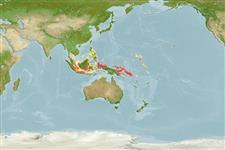>
Blenniiformes (Blennies) >
Blenniidae (Combtooth blennies) > Blenniinae
Etymology: Meiacanthus: Greek, meion = less = lessen + Greek, akantha = thorn (Ref. 45335).
Environment: milieu / climate zone / depth range / distribution range
Ökologie
seewasser riff-verbunden; tiefenbereich 1 - 30 m (Ref. 48636). Tropical
Western Pacific: Irian Jaya, Indonesia to the Solomon Islands.
Size / Gewicht / Alter
Maturity: Lm ? range ? - ? cm
Max length : 8.5 cm TL Männchen/unbestimmt; (Ref. 48636)
Rückenflossenstacheln (insgesamt) : 3 - 4; Rückenflossenweichstrahlen (insgesamt) : 25 - 27; Afterflossenstacheln: 2; Afterflossenweichstrahlen: 17 - 21. Pale grey on upper half, whitish below with bold black mid-lateral stripe. Dorsal rays usually IV; segmented caudal rays 11-12; outer lobe of caudal fins filamentous in adult males; body depth ca. 5.0 in SL. Maximum size to 6.5 cm TL (Ref. 90102).
Adults are found in coral reefs, usually on sheltered inshore reefs (Ref. 41819) which occur mainly solitarily (Ref. 48636). Oviparous. Eggs are demersal and adhesive (Ref. 205), and are attached to the substrate via a filamentous, adhesive pad or pedestal (Ref. 94114). Larvae are planktonic, often found in shallow, coastal waters (Ref. 94114). Mimicked by Cheilodipterus parazonatus and juvenile Scolopsis margaritifer (Ref. 90102) and juvenile Cheilodipterus zonatus (Ref. 9710). Also mimicked by the apogonid C nigrotaeniatus which is much more widespread and adapts in coloration to various Meiacanthus spp. Minimum depth of 1 m reported from Ref. 90102.
Life cycle and mating behavior
Geschlechtsreife | Fortpflanzung | Ablaichen | Eier | Fecundity | Larven
Oviparous, distinct pairing (Ref. 205).
Masuda, H. and G.R. Allen, 1993. Meeresfische der Welt - Groß-Indopazifische Region. Tetra Verlag, Herrenteich, Melle. 528 p. (Ref. 9137)
IUCN Rote Liste Status (Ref. 130435: Version 2024-2)
Bedrohung für Menschen
Harmless
Nutzung durch Menschen
Fischereien: kommerziell; Aquarium: Kommerziell
Tools
Zusatzinformationen
Download XML
Internet Quellen
Estimates based on models
Preferred temperature (Ref.
123201): 28 - 29.2, mean 28.8 °C (based on 351 cells).
Phylogenetic diversity index (Ref.
82804): PD
50 = 0.5000 [Uniqueness, from 0.5 = low to 2.0 = high].
Bayesian length-weight: a=0.00575 (0.00253 - 0.01308), b=3.06 (2.86 - 3.26), in cm total length, based on LWR estimates for this (Sub)family-body shape (Ref.
93245).
Trophic level (Ref.
69278): 3.4 ±0.4 se; based on size and trophs of closest relatives
Widerstandsfähigkeit (Ref.
120179): hoch, Verdopplung der Population dauert weniger als 15 Monate. (Preliminary K or Fecundity.).
Fishing Vulnerability (Ref.
59153): Low vulnerability (10 of 100).
